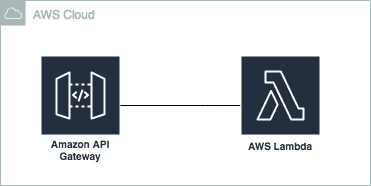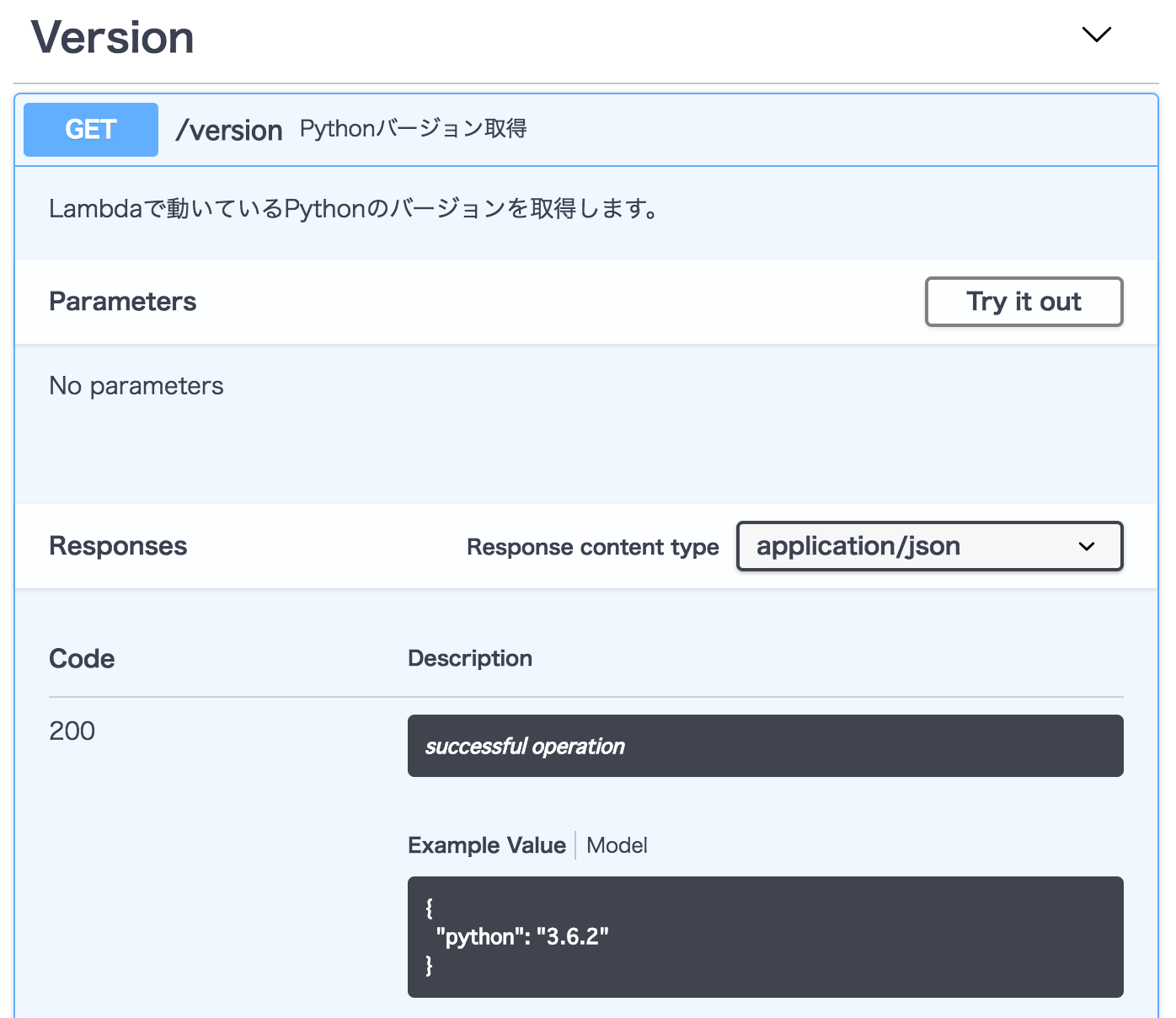【初心者向け】SwaggerとAWS SAMを使ってWebAPIを簡単に作ってみた
サーバーレス開発部の藤井元貴です。インフルエンザに怯えてます。(予防接種はしてる)
API Gatewayでは、WebAPIの作成にSwaggerを使用できます。 Swaggerを使うことで、ドキュメント内容とWebAPI仕様の一致が期待できます(齟齬がない)。
私にとってSwaggerは初めて使うため、ひとまず下記を試してみました。
- Swaggerを使ってWebAPIを作る
- AWS SAMを使う
まずはシンプルに試すため、最低限の内容です。 例えば、開発環境と本番環境(devとprod)のように分けていません。
おすすめ
- SwaggerでAPI Gatewayを定義したい人
- AWS SAMを使いたい人
- サーバーレスなWebAPIに興味がある人
環境
| 項目 | バージョン |
|---|---|
| macOS | High Sierra 10.13.6 |
| AWS CLI | aws-cli/1.16.89 Python/3.6.1 Darwin/17.7.0 botocore/1.12.79 |
| AWS SAM | 0.10.0 |
| Docker for Mac | 18.09.1 |
| Python | 3.6 |
全体概要
WebAPIを作成します。裏側にはLambdaを配置するサーバーレスな構成です。

API Gatewayの定義にSwaggerを使用し、デプロイにAWS SAMを使用します。
WebAPIの仕様
Swaggerを使う前に、まずはWebAPIの仕様を考えます。
| Path | Method | 概要 |
|---|---|---|
| /version | GET | LambdaのPythonバージョンを取得する |
応答パラメータの例は下記とします。
{
"python": "3.6.2"
}
AWS SAMプロジェクトの準備
下記コマンドでプロジェクト一式を作成します。
sam init --runtime python3.6 --name SwaggerSample
Swagger Editor
導入
こちらを参考に導入します。Dockerは便利ですね。
API定義
Swagger Editorで下記を作成しました。この内容をswagger.yamlとして、AWS SAMプロジェクトフォルダに保存します。
swagger.yaml
swagger: "2.0"
info:
description: "SwaggerとAPI Gatewayのサンプルです。"
version: "1.0.0"
title: "Swagger Sample"
basePath: "/Prod"
tags:
- name: "Version"
schemes:
- "https"
paths:
/version:
get:
tags:
- "Version"
summary: "Pythonバージョン取得"
description: "Lambdaで動いているPythonのバージョンを取得します。"
consumes:
- "application/json"
produces:
- "application/json"
responses:
200:
description: "successful operation"
schema:
$ref: "#/definitions/Version"
x-amazon-apigateway-integration:
uri:
Fn::Sub: arn:aws:apigateway:${AWS::Region}:lambda:path/2015-03-31/functions/${PythonVersionFunction.Arn}/invocations
passthroughBehavior: when_no_templates
httpMethod: POST
type: aws_proxy
definitions:
Version:
type: "object"
required:
- "python"
properties:
python:
type: "string"
API Gatewayで必要となるx-amazon-apigateway-integrationを記載しています。詳細はこちらへ。
なお、下記のようなドキュメントになります。参考まで。

AWS SAM
Lambda関数
Lambda関数のコードは下記です。Pythonバージョンの文字列を返却します。
app.py
import sys
import json
def lambda_handler(event, context):
version = f'{sys.version_info.major}.{sys.version_info.minor}.{sys.version_info.micro}'
return {
"statusCode": 200,
"body": json.dumps(
{"python": version},
),
}
templateファイル
AWS SAMのtemplate.yamlは下記です。
template.yaml
AWSTemplateFormatVersion: '2010-09-09'
Transform: AWS::Serverless-2016-10-31
Description: >
SwaggerSample
Sample SAM Template for SwaggerSample
Globals:
Function:
Timeout: 3
Resources:
PythonVersionApi:
Type: AWS::Serverless::Api
Properties:
StageName: Prod
DefinitionBody:
Fn::Transform:
Name: AWS::Include
Parameters:
Location: s3://cm-fujii.genki-sam-test-bucket/swagger.yaml
PythonVersionFunction:
Type: AWS::Serverless::Function
Properties:
CodeUri: hello_world/
Handler: app.lambda_handler
Runtime: python3.6
Events:
HelloWorld:
Type: Api
Properties:
Path: /version
Method: get
RestApiId: !Ref PythonVersionApi
Outputs:
PythonVersionApiUrl:
Description: "API Gateway endpoint URL for Prod stage for Python Version Function"
Value: !Sub "https://${PythonVersionApi}.execute-api.${AWS::Region}.amazonaws.com/Prod/version"
Type: AWS::Serverless::ApiでAPIを明示的に定義し、S3に格納してあるyamlファイル(swagger.yaml)を指定します。
S3
コード等を格納するためのS3バケットを作成します。作成済みの場合は飛ばします。
aws s3 mb s3://cm-fujii.genki-sam-test-bucket
Swaggerファイルを格納
SwaggerファイルをS3バケットに格納します。
aws s3 cp swagger.yaml s3://cm-fujii.genki-sam-test-bucket/swagger.yaml
ビルド
下記コマンドでビルドします。
sam build
動作確認(ローカル)
まずはAPIを準備します。
sam local start-api
続いてcurlでAPIを叩きます。
$ curl http://localhost:3000/version
{"python": "3.6.1"}
OKですね!
package
続いてコード一式をS3バケットにアップロードします。
sam package \
--output-template-file packaged.yaml \
--s3-bucket cm-fujii.genki-sam-test-bucket
deploy
最後にデプロイします。
sam deploy \
--template-file packaged.yaml \
--stack-name SwaggerSample \
--capabilities CAPABILITY_IAM
動作確認
作成したWebAPIのエンドポイントを確認します。
Web画面ポチポチでも良いですが、せっかくなのでコマンドを使います。
$ aws cloudformation describe-stacks --stack-name SwaggerSample --query 'Stacks[].Outputs'
[
[
{
"OutputKey": "PythonVersionApiUrl",
"OutputValue": "https://hogehoge.execute-api.ap-northeast-1.amazonaws.com/Prod/version",
"Description": "API Gateway endpoint URL for Prod stage for Python Version Function"
}
]
]
では、作成したWebAPIを叩いてみましょう!
$ curl https://hogehoge.execute-api.ap-northeast-1.amazonaws.com/Prod/version
{"python": "3.6.8"}
Python3系で最新の3.6.8が使用されていました。
ハマったこと
Swaggerの記載で下記にハマりました。
definitionsにexampleを記載すると、sam deployが失敗する- WebAPIのMethodがGETでも、
x-amazon-apigateway-integrationのhttpMethodはPOSTを指定する
どちらもAWS(AWS SAM、API Gateway、Lambda)との連携部分です。辛かった……。
Swagger Editorですべて頑張らずに、AWSのWeb画面でAPI Gatewayをポチポチ作成したあと、Swagger形式でエクスポートするのも有効です。むしろこのほうが効率良さそう。
さいごに
SwaggerとAWSの組み合わせは、使い倒すほどハマる点が増えそうに感じましたが、Infrastructure as Codeは良いですね!! 楽しいです!
'DevOps > swagger' 카테고리의 다른 글
| openapi의 yaml파일 작성법 (0) | 2020.01.15 |
|---|